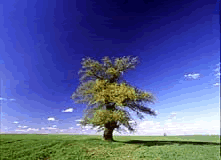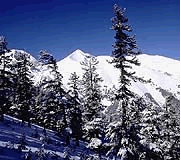|
Nature
Bulgaria occupies a relatively small area - 111 000
sq. km, but is nevertheless distinguished by generous and varied nature - a
sea with a 380 km. long coastal strip and golden beaches, 16 mountains with
their own characteristic features, shelters valleys and high plateaus, over
550 curative mineral springs, dozen of unique natural phenomena and 2000
thrilling caves, a healthy climate and diverse flora and fauna.
As a whole Bulgaria's vegetation can be ranked among the Central
European forest region, but the influence of the South Russian and Asia
Minor regions is also felt. The higher part of Bulgarian mountains are
covered by sub -Arctic vegetation, among which juniper forests predominate.
In fact, Bulgaria boasts 3000 higher plant varieties - almost twice as many
as in England.
More then one quarter of the country's territory is covered with forests.
The edelweiss which grows in places difficult of access in the Pirin
Mountains and the Balkan Range, is one of the rare plants growing in the
country.
Bulgaria is famous for its oleaginous rose which bloom in the Valley of
Roses. The Bulgarian tobacco brands are world - famous.
The Bulgarian fauna is no less interesting, with almost 13 000 animal
species and subspecies, or about 14 percent of all European species.
Fishing is possible in lakes, dams, mountain brooks and sea, hunting - in
special hunting grounds.
|
 |
|
Sea
Pontus
euxinos - hospitable sea.
This is how the ancient Greeks called the Black Sea, a sea that is indeed
tempting and hospitable - clean and calm, without any tides or dangerous
animals. The sandy sea bottom slopes gently, making bathing and swimming
safe for even the youngest holidaymakers. The Black Sea is half as saline as
the Mediterranean.
The Bulgarian coastal stretch faces east and extends over 378 km, dotted
with vast beaches covered with fine golden sand. The majority of Bulgaria
beaches have been awarded the EU Blue Flag for their environmental exellence.
Air temperatures in summer vary between 23°C and 27°C, water temperatures
between 17°C and 25°C. There are more than 240 hours of sunshine in May and
September, and more than 300 in July and August. The deep-cutting coves and
rugged shores, wooded hills and romantic peninsulas, vineyards and orchards,
fishing towns and secluded campsites lend a unique fascination to the
Bulgarian Black Sea coast.
Holiday-makers have a huge selection of resorts and accommodation to choose
from - depending on their budget and on the kind of holiday they are
interested in. They can find anything from luxurious 4 to 5-star hotels,
large holiday hotel complexes, private hotels, small guesthouses - to more
seduled holiday villages, villas and B & B style rooms.
The large major sea resorts - Albena, Golden Sands, Riviera Holiday Club,
Sunny Day Tourist Complex, St. Constantine, Elenite Holiday Village, Sunny
Beach, Dyuni Holiday Village- tempt with luxury, innumerable sports
facilities, entertainment and inland trips to noteworthy landmarks.
Mountains
Rugged snow-capped peaks and soft green slopes, cool
forests carrying the aroma of herbs and wild fruit, quick-flowing rivers and
crystal-clear blue lakes, mineral springs and bioreserves, rare plants and
game, large climatic and ski resorts and small picturesque villages with
living traditions and folklore - every Bulgarian mountain has its own
characteristic appearance, fascination and beautiful name.
|
 |
|
Lakes
Glacial lakes are most numerous in Bulgaria. There
are about 280 of them, located in the high mountain zones of the Rila and
Pirin Mountains. Most are situated at altitudes of 2,200-2,400 m, the
highest lying lake - Ledenika Lake in the Rila Mountains - being situated at
an altitude of 2,715 m.
The lakes freeze around October and melt in June. The ice cover can be up to
two metres thick. In summer they get their water from the melting
snow-drifts on the mountain screes and peaks. Most of them flow into wild
streams from which the big Bulgarian rivers - Iskur, Maritsa and Mesta -
take their course.
These lakes either form separate groups or are located singly.
There are about 190 glacial lakes in the Rila Mountains. Most of them are
scattered in circuses, but there are also a number of large groups of lakes:
the Ribni (Fish), Malyovitsa and Moussala lakes, the Seven Rila Lakes, etc.
Their depth varies between three and 40 meters. Okoto Lake (The Eye) is the
deepest - 39 m. Average visibility is from 6 to 15 m.
The Pirin Mountains boast about 158-164 lakes, covering an area of 180
hectares. The larger lake groups include: Demyanitsa and Bunderitsa and the
lakes along the Sandanska Bistritsa and Retizhe rivers. Average visibility
is 15 m.
The champion of the Pirin lakes is Popovo Lake, also known as the "Pirin
Sea". Located in the largest circus, it covers an area of 12.4 ha and is 480
m long and 336 m wide. The small rocky peninsula Popova Kapa, a popular
tourist target, is located in its northwestern part.
The best known group of lakes in the Rhodopes are the Smolyan Lakes. They
are located in the Western Rhodopes. Seven in all, they are
amphitheatrically situated. The natural phenomenon Orlovi Skali (Eagle's
Rocks) rises in the vicinity.
|